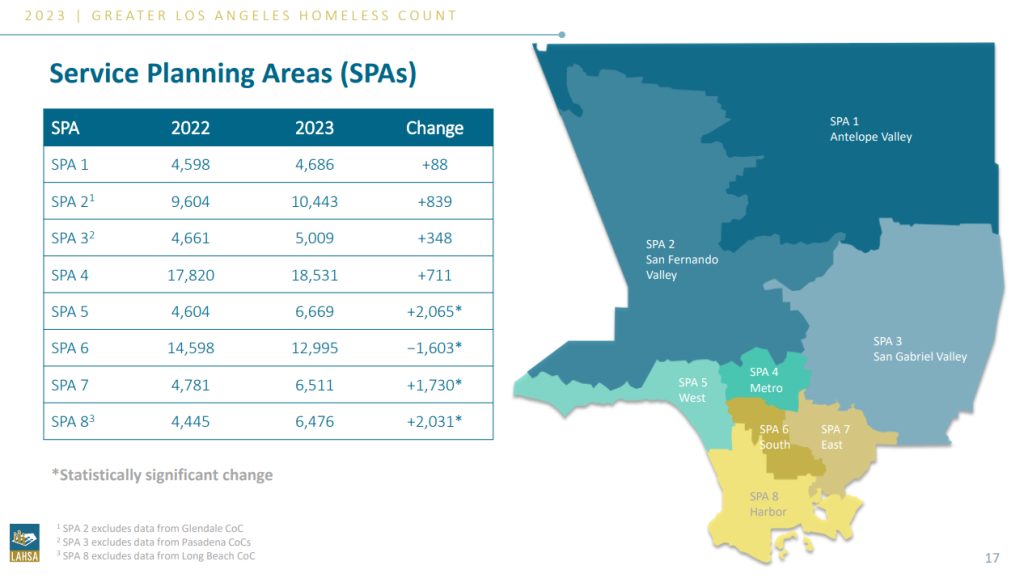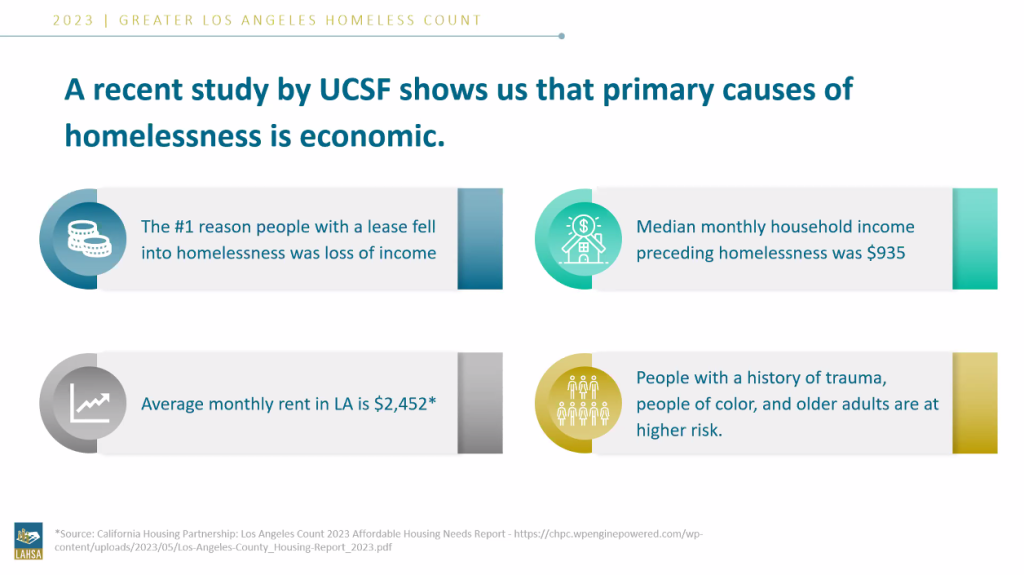The Number of the Unhoused Has Risen Significantly Since 2022
By Dolores Quintana
The 2023 Greater Los Angeles Homeless Count results were released today, indicating a 9% increase in homelessness on any night in Los Angeles County, with an estimated 75,518 individuals affected. In the City of Los Angeles, there was a 10% rise, reaching an estimated 46,260 people. While these increases are slightly lower compared to previous years, they continue the ongoing trend of steady growth in homelessness, as observed in the annual Point-in-Time Count (PIT Count).
The rise in homelessness in Los Angeles County is concurrent with similar increases in major cities throughout the United States. Chicago and Portland, for instance, experienced double-digit increases of 57% and 20%, respectively. Moreover, several Southern California counties reported larger increases than Los Angeles, including San Bernardino (+26%), San Diego (+22%), Kern (+22%), and Riverside (+12%).
While the number of individuals in interim housing remained steady at 20,363, the increase in the number of people experiencing unsheltered homelessness aligned with the overall rise observed in the PIT Count.
Dr. Va Lecia Adams Kellum, Chief Executive Officer of the Los Angeles Homeless Services Authority (LAHSA), remarked, “The homeless count results tell us what we already know — that we have a crisis on our streets, and it’s getting worse. The important thing to take away from today is that for the first time, the city, county, and LAHSA are urgently moving to house the people living on our streets.”

During a press conference, Mayor Karen Bass and Supervisor Lindsay Horvath, also a LAHSA Commissioner, joined Dr. Adams Kellum to discuss their collaborative efforts in addressing unsheltered homelessness. Dr. Adams Kellum emphasized the need for collaboration and coordination to combat this issue, citing past successes in reducing homelessness among specific populations, such as veterans. She stressed the importance of applying that mindset to address unsheltered homelessness countywide, stating, “We are all dedicated to addressing street homelessness. We’ve already succeeded with our early efforts but must work together to scale them enough to address this humanitarian crisis.”
LAHSA recently released data indicating that emergency declarations made in LA City and County have led to improvements in the timeline for transitioning individuals from the streets to interim housing. The timeline has been reduced to 61 days for the adult population, nearly half the duration compared to early 2021. Similarly, the transition period for the transition-aged youth (TAY) population has seen a more than 50% reduction, from 127 days to 59. These improvements have also coincided with a nearly 30% increase in interim housing placements.
To further expedite systemic improvements in addressing unsheltered homelessness, Dr. Adams Kellum announced the establishment of a Multi-Department Crisis Response Team (MDCRT) within LAHSA. The MDCRT aims to enhance collaboration between LAHSA, the City, and the County to implement policies like master and batch leasing, scaling up the leasing process, expanding housing navigation, and ensuring document readiness among people experiencing homelessness. The goal of the MDCRT is to reduce the timeline for moving individuals indoors to the teens.
Mayor Bass announced earlier this month that, within the first six months of her administration, over 14,000 people had transitioned from LA’s streets to interim or permanent housing, with more than 4,300 obtaining permanent housing. The mayor’s Inside Safe program accounted for over 1,300 of these placements. While acknowledging the progress, Mayor Bass emphasized that much work is ahead to end unsheltered homelessness.
Los Angeles County Supervisor Lindsey P. Horvath declared, “Today’s announcement confirms why we are in a state of emergency: more Angelenos continue falling into homelessness than we can house.” Supervisor Horvath highlighted the success achieved over the last six months through a unified approach connecting more people to housing and services. She stressed the need to address the root causes of homelessness by investing in families, making housing more affordable, and keeping people in their existing homes.
While the leaders involved in LA’s homelessness response work together to eliminate street homelessness, they agree that more must be done to address the underlying causes. A recent study by UC San Francisco’s Benioff Homelessness and Housing Initiative identified unaffordable rents as the primary cause of homelessness among Californians, with half of the study participants reporting receiving a five-day or fewer warning before losing their homes.

Although the City and County are on track to create approximately 8,200 affordable homes this year, all leaders recognize the ongoing need for more affordable housing. They pointed to initiatives such as Measure ULA and the upcoming LA County Affordable Housing Solutions Agency (LACAHSA) as potential mechanisms to help people stay in their homes and boost affordable housing development. Mayor Bass also highlighted her efforts to expedite the development process for affordable housing within Los Angeles.
Increasing the availability of affordable housing could contribute to a higher number of permanent housing placements each year. LAHSA reported that, in collaboration with its partners, it facilitated 22,540 placements in 2022. This marks the fifth consecutive year since the implementation of Measure H that the homeless rehousing system has achieved over 20,000 permanent housing placements.

























